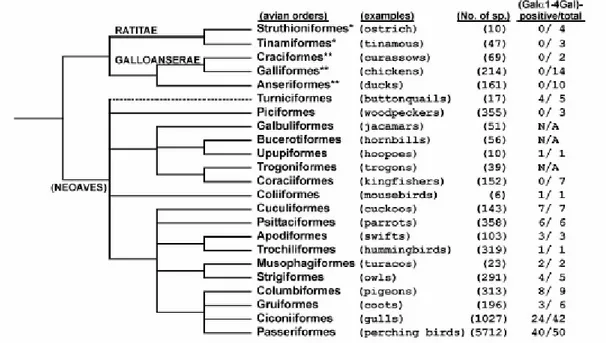D. Chessel - Biométrie et Biologie Évolutive - Université Lyon 1
_____________________________________________________________________________ Galabiose et phylogénie / Page 1 / 29-07-04
http://pbil.univ-lyon1.fr/R/pps/pps026.pdf
Problème Pratique de Statistique - 26
Galabiose et phylogénie des Oiseaux
De plus en plus souvent, un article de biologie est dans la nécessité d'afficher une probabilité critique (p-value, P<0.001,***) à la fin d'une phrase sur deux. Pas de traces de p-value dans l'article de N. Suzuki, M. Laskowski et Y.C. Lee (2004).
http://www.pnas.org/cgi/content/abstract/101/24/9023. Pourquoi ?
L'intégralité des données est disponible dans la figure :
Fig. 3. Phylogeny of modern birds and expression of Gal_1-4Gal on avian egg white glycoproteins. The phylogenetic tree is based on DNA–DNA hybridization by Sibley et al. (29). The position of the Turniciformes in their classification is uncertain (p. 255 in ref. 29), and is indicated with dashed line. Avian orders belonging to Ratitae (*) and Galloanserae (**) are indicated with asterisks. Non-Ratitae_Galloanserae modern birds are sometimes called Neoaves. The examples of birds and recorded number of species in each order (27) are indicated in parentheses. Ciconiiformes in Sibley’s classification (27, 28) are traditionally classified as Charadriiformes (e.g., gulls), Falconiformes (e.g., eagles), Podicipediformes (grebes), Pelecaniformes (e.g., tropicbirds), Ciconiiformes (e.g., storks), Sphenesciformes (penguins), Gaviiformes (loons), and Procellariformes (e.g., albatrosses). The number of Gal_1-4Gal-positive species and the total species examined in this study are indicated in the right column. N_A, not available. [Modified from ref. 29 with permission from Yale Univ. Press (Copyright 1990, Yale Univ. Press).]
Les auteurs ont recherché la présence de la galabiose Galα1-4Gal dans les glycoprotéines des blancs d'œufs. 181 espèces de 20 ordres ont été étudiées. On voit sur la figure une phylogénie compromis, la liste des noms des ordres, une illustration, le nombre d'espèces de l'ordre et sous la forme nombre de succès / nombre d'essais le nombre d'espèces positives dans chaque groupe. Le résumé dit :
One of the significant observations is the total absence of Gal{alpha}1-4Gal glycoproteins in Struthioniformes (four species), Tinamiformes (three species), Craciformes (two species), Galliformes (14 species), and Anseriformes (10 species), which are phylogenetically separated from other orders at earlier stage of modern bird diversification (100-65 million years ago).
On pourra, à partir de cette présentation particulièrement originale : - saisir la phylogénie au format Newick ;
D. Chessel - Biométrie et Biologie Évolutive - Université Lyon 1
_____________________________________________________________________________ Galabiose et phylogénie / Page 2 / 29-07-04
http://pbil.univ-lyon1.fr/R/pps/pps026.pdf - poser le problème statistique qui émerge des ces données ;
- repérer ce qui revient à la signification statistique et à la signification biologique, non sans avoir lu avant l'article de G. Yoccoz (1991).
Suzuki, N., Laskowski, Michael, Jr., and Y. C. Lee. 2004. Phylogenetic expression of Galα1-4Gal on avian glycoproteins: Glycan differentiation inscribed in the early history of modern birds. PNAS 101:9023-9028.
Yoccoz, N. G. 1991. Use, overuse, and misuse of significance tests in evolutionary biology and ecology. Bulletin of the Ecological Society of America 72:106-111.
